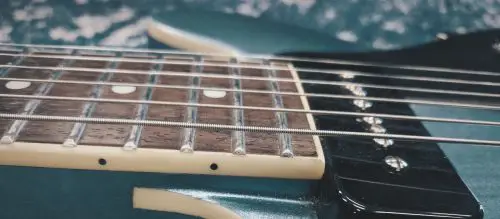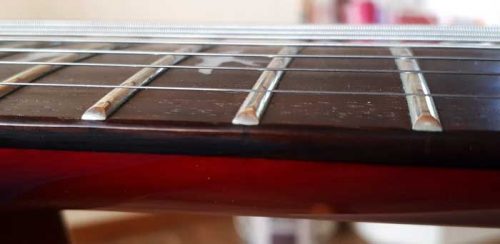Low action strings are usually easier to play than high action. Low action allows you to play faster and easily perform techniques like bends or slides.
However, other techniques like hammer ons and pull offs become harder with low action and you will have much more fret buzz.
The topic of high action vs low action strings have been going on for a long time now (especially for beginners who have never tried both).
I also had many questions when I first started. However, those questions were answered the moment I switched to lower action and experienced both actions first hand.
In this article, I am going to compare high action and low action strings extensively. You should be able to decide which ones suit you more. Though, I strongly recommend you try both and then decide.
High Vs Low Action String
| High Action | Low Action | |
| String height
(from 12th fret) |
> 3.5 mm | < 2 mm |
| Ease of play
(overall) |
Harder | Easier |
| Slides / bends | Harder | Easier |
| Hammer / pull offs | Easier | Harder |
| Speed | Slower | Faster |
| Fret Buzz | Minimal | Significant |
| Suitable play style | Aggressive | Softer |
String Height: High Action Vs Low Action
When measured from 12th fret, any height below 2 mm is considered a low action, whereas anything above 3.5 mm is high action. Anything in between is normal.
When measuring string action, make sure you measure from the 12th fret because it’s far away from the nut and should be more accurate. A nut with high slots can make your reading seem higher than it actually is.
Also make sure to remove capos or any other tools that could influence the string height. I recommend you measure the height while you are in the playing position.
I recommend going for a 1.5 mm height for low action or go for 3.5 mm height for high action.
Ease Of Play: High Action Vs Low Action
Low action strings should be easier to play than high action (overall). This is because you don’t have to press as hard – allowing you to play fast and smoothly.
Low action string is even better if you do a lot of hammer ons and pull offs. You need less pressure and there’s less travel.
That said, doing bends or slides is harder with a low action string. You have to be careful and precise, otherwise you will get a lot of fret buzz.
For the best playing guitar, I recommend going as low as possible – while keeping fret buzz at a minimum. More about this here – Low Action String: Is Fret Buzz Ok? (Guide To Stop & Fix It)

High action string is harder to play and will slow you down.
Speed: High Action Vs Low Action
Low action string allows you to play faster than high action – there’s less travel when fretting and you can smoothly glide through the fretboard.
If you care about speed the most, I recommend giving a low action string a try. It should improve your speed significantly (like it did to me).
Try 1.5 mm action. If it doesn’t generate too much fret buzz to you, then it should be perfect.
Fret Buzz: High Action Vs Low Action
Low action strings will yield much more fret buzz than high action. This depends on how low you go – but the lower, the more fret buzz.
Fret buzz happens when the string touches an unintended fret bar – causing the string to buzz. This is the biggest problem with low strings.
That said, fret buzz is usually insignificant if you play a dirty tone with high gain. It’s only significant if you play acoustic with a clean tone.
To reduce fret buzz, you need to make sure your neck relief is neutral (not too straight or bowed). You can easily adjust by turning the guitar’s truss rod using an Allen key.
You could also look into fret dressing to reduce fret buzz. Complete information about fret buzz here – Low Action String: Is Fret Buzz Ok? (Guide To Stop & Fix It)
Most of the time fret buzz will not be a big problem. Many guitarists test fret buzz by simply plucking one or 2 strings. This is not realistic. Test the fret buzz by actually playing the guitar. Most of the time – it’s not as bad as you think.

Low action string is prone to fret buzz
Suitable Playstyle: High Action Vs Low Action
Low action strings are suitable for softer playing, whereas high action strings are suitable for harder and more aggressive playing.
If you like to play hard and strum hard, then high action is more suitable for you. With low action, hard strums translate directly to fret buzz.
If you insist on playing with low strings, then you need to go easy on the hard strumming or plucking.
Does High Or Low Action Sound Better?
Both high or low action strings should sound the same – it will not change any sound vibrations or tone.
Though, you have to be careful about the techniques. Low action strings result in more fret buzz – which could impact the sound of your playing (especially bends / slides)
On the other hand, it’s harder to play high action strings because you need to press harder.
Both high action and low action strings can indirectly impact sound because they impact your playing. However, they do not change tone, vibrations or resonance just by themselves.
How To Adjust Guitar Action?
To adjust a guitar action, you need to adjust the following components:
- The nut
- The saddle
- Truss rod
For the nut and saddle, you will need to sand some of the material off to go lower (it’s irreversible).
As for the truss rod, you need to use an Allen key to adjust. This is reversible but you have to be careful and do it very slowly. Big turns on the truss rod can result in massive change.
I personally wouldn’t try to do it myself. Save up some money and have a professional adjust your actions for you. They know the right measurement and can make sure your guitar plays well after the adjustment.
If you were to adjust yourself, you could potentially damage your guitar for good. That said, here’s a YouTube video showing you how to adjust a guitar action. Skip to 3:43
Conclusion
Both high action and low action strings are viable. It just depends on the player and what you want to achieve.
If you don’t have any specific needs, then it’s generally easier to play with low action strings. Many guitarists go as low as they can before they get any fret buzz.
You can follow the same approach but fret buzz is generally not an issue while you play. They are hardly noticeable by the untrained ears – especially if you play with high gain.
I recommend giving both high action and low action a try. See which one you prefer and stick with it. Once you are familiar with one, then you can be flexible and have two guitars with two different settings.






